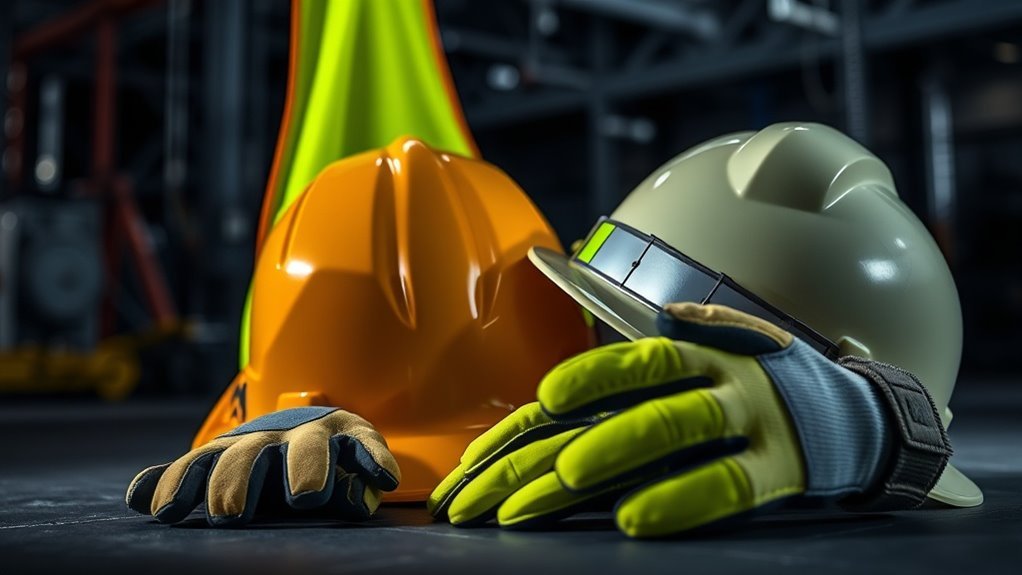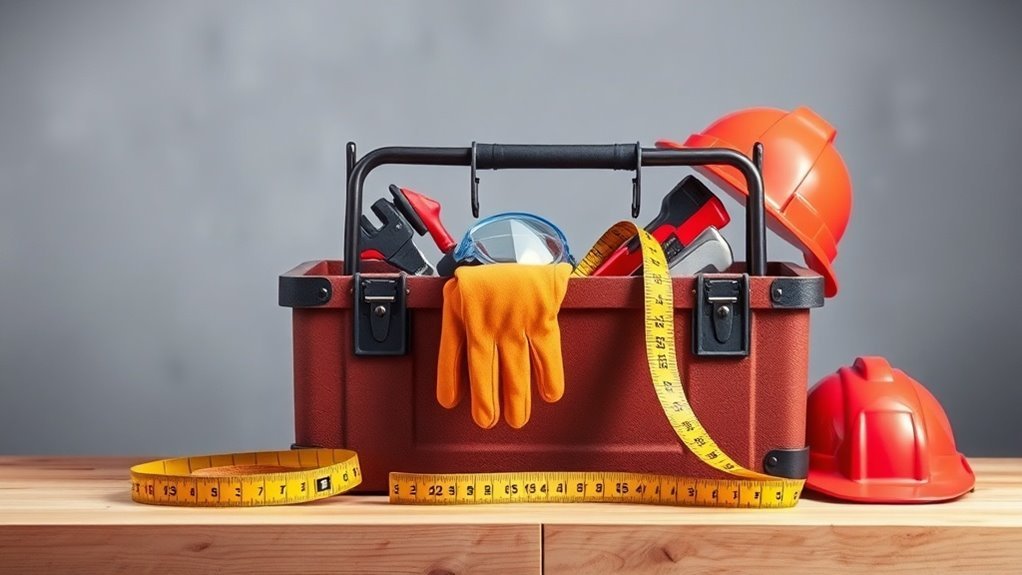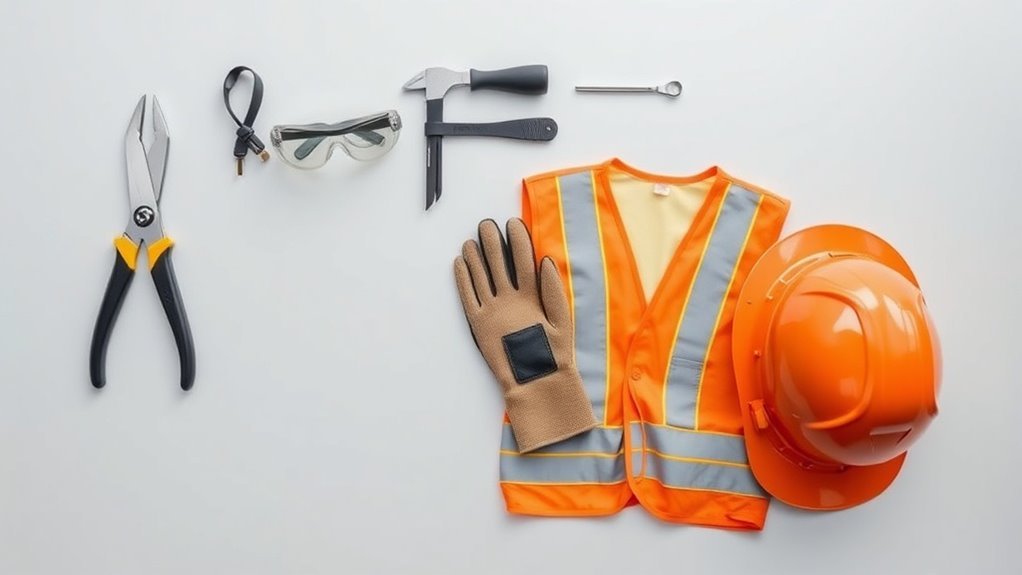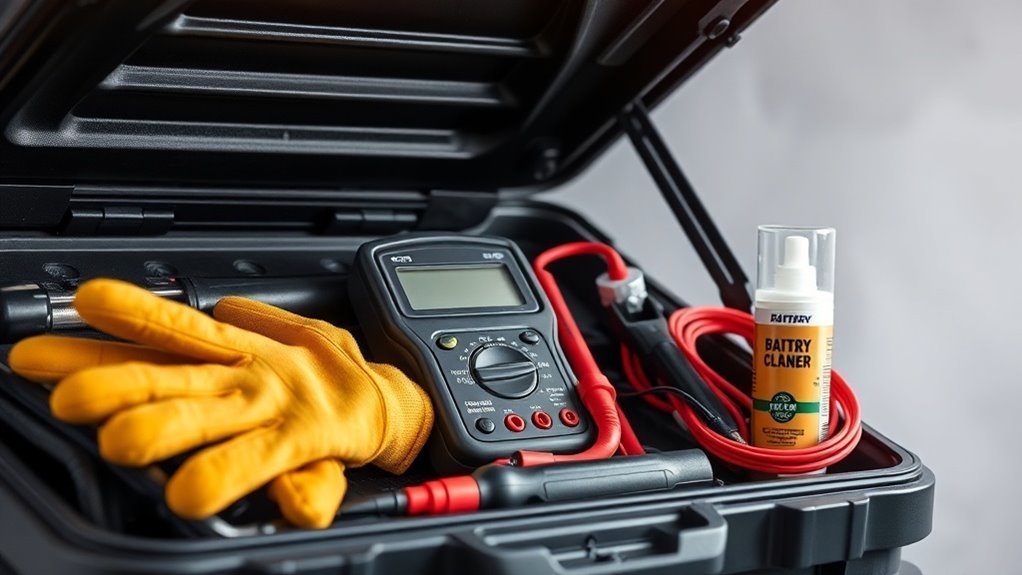Reflective Safety Gear and Its Applications

Reflective safety gear is essential for improving your visibility in low-light situations, whether you’re jogging, working in construction, or supporting roadside assistance. It comes in various forms like vests, jackets, and armbands, designed to keep you safe and easily seen. You’ll find that modern gear includes innovative features like smart textiles and wearable sensors for added functionality. If you’re curious about the different applications and the future of reflective safety solutions, there’s more to explore.
Key Takeaways
- Reflective safety gear enhances visibility in low-light conditions, making it essential for various activities like jogging or working in construction.
- Industries such as transportation, emergency services, and waste management benefit significantly from reflective gear, ensuring safety near moving vehicles and hazardous environments.
- Innovative designs include features like smart fabrics, built-in communication systems, and augmented reality, improving both safety and user experience.
- Regular maintenance, such as proper cleaning and fitting, maximizes the effectiveness and longevity of reflective gear for users.
- Sustainable materials and manufacturing practices are increasingly being incorporated to minimize environmental impact while maintaining essential visibility and safety functions.
Understanding Reflective Safety Gear
Reflective safety gear is crucial for enhancing visibility in low-light conditions.
When you wear reflective materials, you effectively increase your chances of being seen by others, whether you’re working on the road or enjoying a nighttime jog.
This type of gear comes in various forms, including vests, jackets, and accessories like armbands or hats, designed to maximize your visibility.
By incorporating reflective items into your wardrobe, you gain peace of mind knowing you’re taking proactive steps to guarantee your safety.
It’s critical to recognize that active visibility not only protects you but also helps others see you in challenging environments.
Key Features of Effective Reflective Materials

When you’re choosing reflective materials, it’s essential to look for specific key features that enhance their effectiveness.
First, check the brightness. The higher the reflectivity, the more visible you’ll be in low-light conditions.
Next, consider the durability; materials should withstand wear and tear from weather and rough use.
You’ll also want to confirm that the fabric is flexible and lightweight for comfort during prolonged wear.
Breathability is another vital feature, as it helps you stay cool and dry.
Finally, look for materials that follow safety standards, making sure they meet industry regulations.
Industries Benefiting From Reflective Safety Gear
Numerous industries rely on reflective safety gear to protect workers in low-light environments.
Construction sites, where heavy machinery and traffic coexist, benefit from gear that enhances visibility for both workers and drivers.
Similarly, the transportation sector uses reflective vests to guarantee drivers and roadside workers are seen at night or during poor weather.
Emergency services, including police and firefighters, frequently wear reflective gear to amplify their safety when responding to incidents.
Waste management workers also utilize this equipment, as they often operate near moving vehicles.
Additionally, manufacturing facilities often employ reflective clothing to safeguard employees working in dimly lit areas.
In each case, investing in reflective safety gear considerably boosts visibility, ultimately reducing the risk of accidents and injuries.
Innovative Designs and Technologies
When it comes to reflective safety gear, innovative designs and technologies are changing the game.
You’ll find smart fabric integration for added functionality, enhanced visibility features for better safety, and eco-friendly materials that make a positive impact.
These advancements not only improve performance but also align with a more sustainable future.
Smart Fabric Integration
As technology evolves, smart fabric integration is transforming reflective safety gear into highly functional wearable solutions. You’ll find fabrics embedded with sensors that monitor essential signs like heart rate and temperature, enhancing personal safety and comfort.
With built-in communication features, you can stay connected without relying on separate devices, increasing your situational awareness in various environments.
Moreover, these fabrics can adjust to weather conditions, offering breathability and insulation when needed. Many designs incorporate lightweight materials, ensuring flexibility and ease of movement, so you won’t feel restricted while wearing this gear.
As these innovations continue to develop, you’ll discover even more ways smart fabrics can elevate your safety experience, merging functionality with style for modern users on the go.
Enhanced Visibility Features
Innovative designs are considerably improving the visibility features of reflective safety gear, making it more effective and user-friendly. These advancements guarantee your safety is prioritized, whether you’re on a construction site or biking at night.
Here are some enhanced visibility features you’ll love:
- 360-Degree Reflectivity: Guarantees you’re seen from all angles, providing complete safety.
- High-Contrast Colors: Bright colors combined with reflective materials make you stand out even in low light.
- LED Integration: Built-in lights can alert others to your presence, enhancing visibility further.
- Patterned Reflective Surfaces: Unique designs not only look stylish but also reflect more light, increasing your visibility dramatically.
These features not only enhance safety but can also boost your confidence when working or traveling in low-light conditions.
Eco-Friendly Materials Usage
While many safety gear options prioritize visibility, an equally important trend is the shift toward eco-friendly materials. You’ll find that brands are increasingly using recycled fabrics, organic cotton, and biodegradable components in reflective gear. This not only reduces environmental impact but also meets consumer demand for sustainable products.
Here’s a quick look at popular eco-friendly materials in safety gear:
| Material | Benefits | Usage |
|---|---|---|
| Recycled Polyester | Reduces waste, durable | Outer layers, vests |
| Organic Cotton | Biodegradable, soft | Base layers, linings |
| Hemp | Strong, naturally resistant | Straps, reflective bands |
| Tencel (Lyocell) | Moisture-wicking, biodegradable | Inner layers, comfort wear |
Choosing eco-friendly options means you’re making a difference while staying safe.
Best Practices for Using Reflective Gear
When using reflective gear, ensuring a proper fit is essential for both comfort and visibility.
You’ll also want to keep your gear well-maintained and store it properly to maximize its effectiveness.
Let’s explore these best practices to help you stay safe.
Proper Fit Importance
Proper fit is essential for maximizing the effectiveness of reflective safety gear. When your gear isn’t fitting properly, it not only loses its visibility but can also become a safety hazard.
Here are some best practices to guarantee your gear fits well:
- Choose the Right Size: Always refer to sizing charts and try on gear if possible.
- Adjust for Comfort: Use straps, velcro, or other adjustments to guarantee the gear hugs your body without being restrictive.
- Wear Over Existing Attire: Layer your reflective gear over your usual clothing for better visibility and comfort.
- Test Movement: Move around in the gear to guarantee it stays in place during your activities.
With proper fit, you’ll feel safer and more confident while on the job!
Maintenance and Storage Tips
Maintaining and storing your reflective safety gear properly is essential for ensuring its longevity and effectiveness. Start by regularly inspecting your gear for any wear or damage—replace anything that’s frayed or stained.
Clean your reflective materials with mild soap and water, avoiding harsh chemicals that can degrade the fabric. Air drying is best; don’t toss them in the dryer.
When it comes to storage, keep your gear in a cool, dry place away from direct sunlight to prevent fading. Use breathable bags to avoid moisture buildup, which can lead to mold.
Finally, hang your gear or fold it neatly, ensuring it maintains its shape. Following these tips will help keep your reflective gear effective when you need it most.
The Future of Reflective Safety Solutions
How will the evolving landscape of technology shape the future of reflective safety solutions? As we look ahead, various innovations stand to enhance your safety experience.
Imagine gear that not only reflects light but also integrates smart technology to keep you informed and connected. The future’s possibilities are exciting:
Gear of the future will blend light reflection with smart technology, enhancing your connectivity and safety experience.
- Smart textiles that change color based on lighting conditions, maximizing visibility.
- Wearable sensors that monitor environmental hazards and alert you in real-time.
- Augmented reality overlays to aid navigation in low-visibility situations.
- Sustainable materials that maintain visibility while minimizing environmental impact.
Additionally, incorporating sound-dampening materials into reflective safety gear may further enhance user comfort in noisy environments. These advancements promise to redefine your safety gear, making it more intuitive, effective, and eco-friendly, ensuring you stay safer than ever before.
Questions
How Do I Properly Clean Reflective Safety Gear?
To properly clean reflective safety gear, wash it gently in cold water with mild detergent. Avoid bleach, and line dry to maintain reflectivity. Regular maintenance guarantees your gear remains effective and safe during use.
Are There Age Restrictions for Using Reflective Safety Gear?
There aren’t age restrictions for using reflective safety gear; however, it’s essential you select the right size and fit. Kids should always wear properly sized gear to guarantee visibility and safety during activities.
Can Reflective Materials Be Recycled?
Yes, some reflective materials can be recycled, depending on their composition. You should check with local recycling programs to see if they accept these materials, as recycling options may vary by region and type.
What Are Common Misconceptions About Reflective Safety Gear?
You might think reflective gear’s only purpose is a flashy look, but it’s not just about fashion! Some believe it’s unnecessary, while others underestimate its life-saving potential, especially in low-light situations. Don’t get misled!
How Long Does Reflective Safety Gear Last?
Reflective safety gear typically lasts between two to five years, depending on usage and maintenance. You should regularly check for wear and tear to guarantee it remains effective in keeping you safe during low-visibility conditions.
Conclusion
To sum up, reflecting on the importance of reflective safety gear reveals how it’s not just about visibility but also about ensuring safety across various industries. Coincidentally, as innovations continue to emerge, you’re likely to find that the gear evolves alongside the challenges faced by workers. By embracing best practices and staying informed, you can contribute to a safer environment for yourself and others. Ultimately, safety isn’t just a necessity; it’s a shared responsibility.






